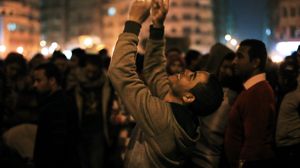The night Hosni Mubarak resigned as President of Egypt is now one of those seminal, where-were-you-when moments. I was half a world away, watching events unfold on the nine o'clock news, marvelling at the sheer size of the crowd gathered in Cairo's Tahrir Square. The images were loud and chaotic, but the commentary was composed, measured, and detached. Watching the same events play out in Jehane Noujaim's documentary The Square was an entirely different experience. I saw some of the same footage, the same iconic images that had made the rounds of traditional media outlets, but packaged so differently, I felt like I was seeing them for the first time.
Filmed between 2011 and 2013, The Square follows a small group of Egyptian revolutionaries at the heart of the Arab Spring. From the end of the Mubarak regime to the country's first democratic election in over 30 years, to the Muslim Brotherhood's rise to power, we witness moments of elation, disillusionment, and confrontations with staggering brutality at the hands of the Egyptian military. With the film crew's footage supplemented by YouTube videos and frantic bursts recorded on smart phones, I couldn't help but think about the monumental task before you and your co-editors. Not only did you have to piece together a coherent narrative of a revolution, you had to construct the story around Tahrir Square, and through the wildly divergent opinions of the subjects, explain the role of the Square itself in the events that unfold.
First, you show us what brought the people to Tahrir Square in the first place. The working class hero, the returned expatriate, the Islamist, the feminist, and the musician all make their way there to demand regime change. The Square becomes a modern day agora, the exchange of goods, ideologies, and opinions in full swing. The optimistic energy of the opening scenes ebbs as the people settle in for the long haul, refusing to leave the square until their demands are met. The tone of unity and camaraderie dissolves as the internal power struggles and military crackdowns begin. A large amount of time is spent accompanying the subjects as they move through the city streets, drawn back again and again, all roads leading to Tahrir. By the time a tenuous new normal emerges, characterized by the juxtaposition of the chaotic and the contemplative, it becomes clear that Tahrir Square is a place where the people will continue to return to negotiate their place in the new order of things.
I loved that you ended the film with images of Tahrir on a night in 2013, astoundingly crowded once again following the ousting of Mohammed Morsi. This is how the world first saw the Square, and rather than having it symbolize a one-off event that dominated the news cycle for a short while a couple of years ago, you remind us that there is no book-ending to be had here, and that all we have actually seen is the beginning of the story.
Best,
Nat.







